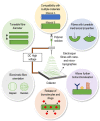A Concise Review on Electrospun Scaffolds for Kidney Tissue Engineering
- PMID: 36290522
- PMCID: PMC9598616
- DOI: 10.3390/bioengineering9100554
A Concise Review on Electrospun Scaffolds for Kidney Tissue Engineering
Abstract
Chronic kidney disease is one of the deadliest diseases globally and treatment methods are still insufficient, relying mostly on transplantation and dialysis. Engineering of kidney tissues in vitro from induced pluripotent stem cells (iPSCs) could provide a solution to this medical need by restoring the function of damaged kidneys. However, implementation of such approaches is still challenging to achieve due to the complexity of mature kidneys in vivo. Several strategies have been defined to obtain kidney progenitor endothelial and epithelial cells that could form nephrons and proximal tube cells, but these lack tissue maturity and vascularisation to be further implemented. Electrospinning is a technique that has shown promise in the development of physiological microenvironments of several tissues and could be applied in the engineering of kidney tissues. Synthetic polymers such as polycaprolactone, polylactic acid, and poly(vinyl alcohol) have been explored in the manufacturing of fibres that align and promote the proliferation and cell-to-cell interactions of kidney cells. Natural polymers including silk fibroin and decellularised extracellular matrix have also been explored alone and in combination with synthetic polymers promoting the differentiation of podocytes and tubular-specific cells. Despite these attempts, further work is still required to advance the applications of electrospun fibres in kidney tissue engineering and explore this technique in combination with other manufacturing methods such as bioprinting to develop more organised, mature and reproducible kidney organoids.
Keywords: developmental biology; disease modelling; electrospinning; iPSCs; kidney organoids; kidney tissue engineering.
Conflict of interest statement
The authors declare no conflict of interest.
Figures
References
-
- Garreta E., Nauryzgaliyeva Z., Montserrat N. Human Induced Pluripotent Stem Cell-Derived Kidney Organoids toward Clinical Implementations. Curr. Opin. Biomed. Eng. 2021;20:100346. doi: 10.1016/j.cobme.2021.100346. - DOI
Publication types
LinkOut - more resources
Full Text Sources



